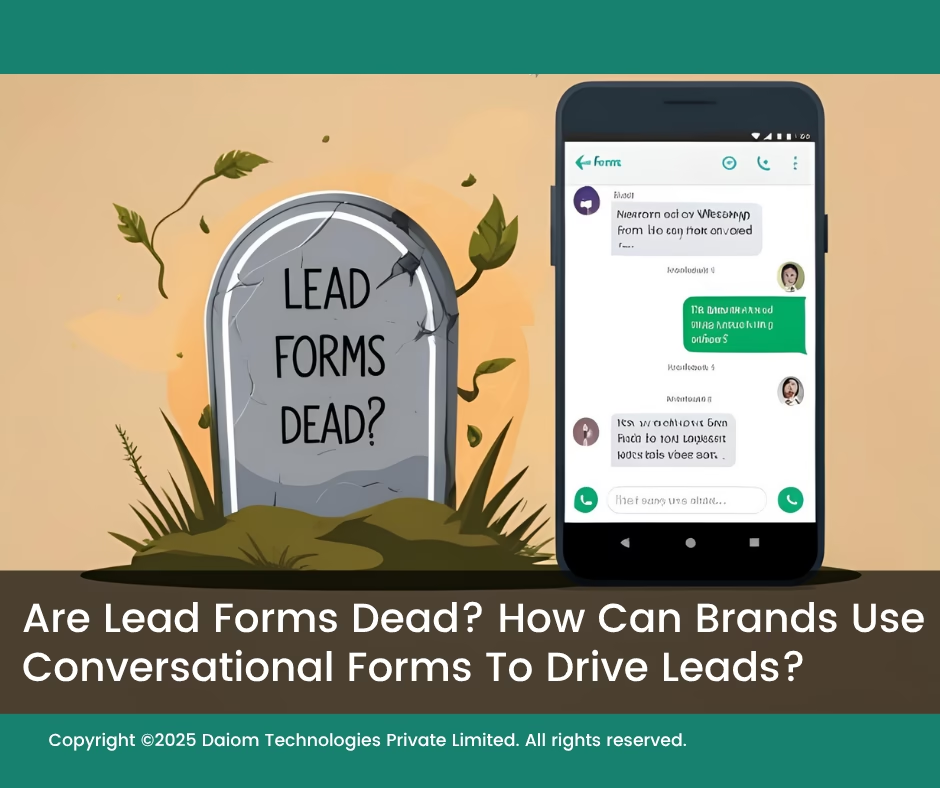Today, nearly 70% of customers turn to the internet to research, compare, and evaluate products or services before making a purchase. They read reviews, dive into product specs, watch videos, and explore all available options online.
But when it comes to high-consideration purchases—like buying a home, a vehicle, premium electronics, or an insurance plan—this online research often isn’t enough. Customers usually want that final reassurance: a conversation with an expert, answers to specific questions, or a little guidance to feel confident in their decision.
That’s exactly where lead forms become a powerful tool for brands. They help capture high-intent interest and seamlessly connect curious prospects with your sales or support teams—at the right time, and in the right way.
A lead form helps brands collect essential customer details and route them to the sales or customer service team. With this information in hand, teams can follow up through calls, messages, or chats—answering queries, offering guidance, and moving prospects closer to conversion.
But the way lead forms operate has evolved.
Why?
Because customer expectations have changed. Today’s buyers have less time and even less patience. Long, complicated forms lead to drop-offs. If the process isn’t quick and easy, brands risk losing high-quality leads at the first step.
That’s why modern lead capture needs to be faster and smarter. Tools like conversational forms, chat-based experiences, and WhatsApp-powered lead flows make it easier for customers to share details—and much easier for brands to drive higher engagement and conversion.
“In today’s digital world, every extra click or step risks losing the customer.”
— Google-BCG Report, 2023
Table of Contents
- Why Do Brands Need Lead Forms?
- Evolution of Lead Forms
- The Full Lead Generation Funnel
- Common Issues with Lead Forms Today
- Who’s Doing It Well and Which Industries Benefit the Most?
- How Does Automation and AI Boost WhatsApp Lead Generation?
- What Are the Best Practices for WhatsApp Lead Generation?
- The Modern Conversion Journey: It’s a Loop, Not a Line
- Conclusion
1. Why Do Brands Need Lead Forms?
Brands typically use lead forms when they’re ready to take the next step in their buying journey, but they still need guidance or validation. After doing all the research they can online, they may still have questions or uncertainties about a product or service.
They might need help clarifying features, comparing options, or understanding which choice is best for their needs. This is where lead forms come in, allowing customers to ask for expert advice or further clarification before making their final decision.
Lead forms act as a bridge between online research and real human assistance. However, for lead forms to be effective, they must be quick and easy to fill out. If they are long or the responses are slow, customers lose interest and drop off.
1.1 What types of businesses need lead forms?
Lead forms are especially useful for businesses where the purchase is high-cost, high-commitment, or complex. These include:
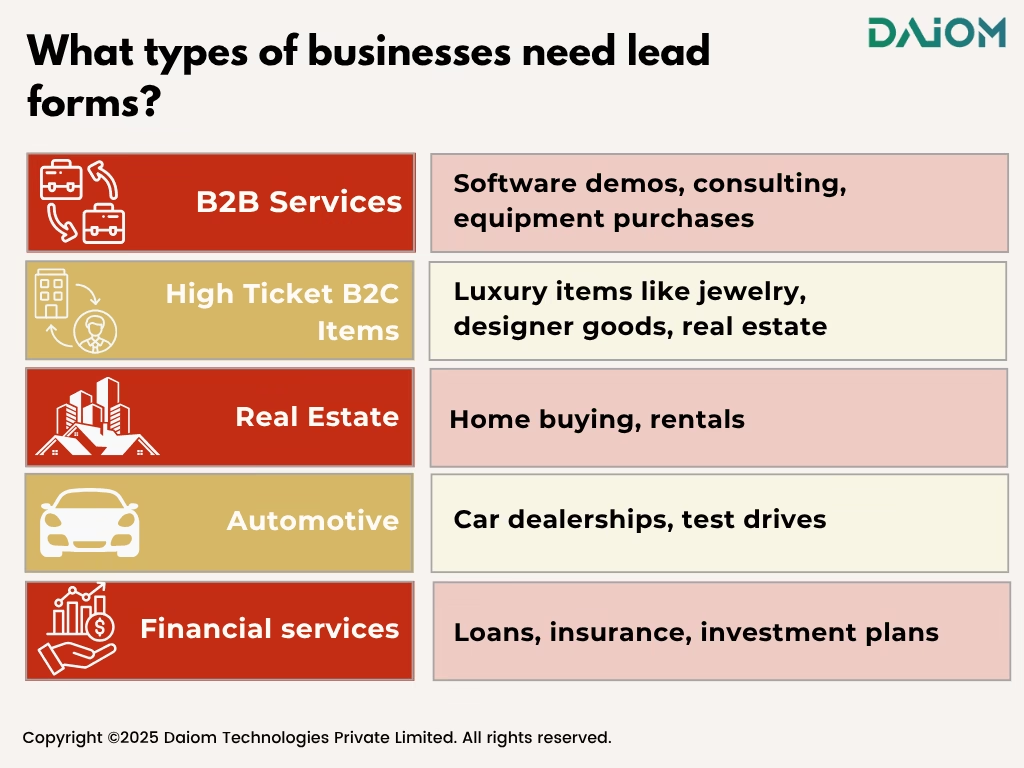
- B2B services → software demos, consulting, equipment purchases
- High-ticket B2C products → luxury items like jewelry, designer goods, real estate
- Real estate → home buying, rentals
- Automotive → car dealerships, test drives
- Financial services → loans, insurance, investment plans
In these industries, people often browse and research online, but they still want to talk to a human before making a decision. That’s why brands need a way to capture these interested leads, so sales or customer service teams can follow up and guide them through the process.
On top of that, lead forms embedded in social media — like pre-filled forms on Instagram — make it even easier for users to show interest without leaving the app, helping brands collect leads seamlessly.
2. Evolution Of Lead Forms in 3 Stages
Lead forms have come a long way — and this evolution has played a big role in improving customer experience, lead quality, and lowering cost per lead for businesses.
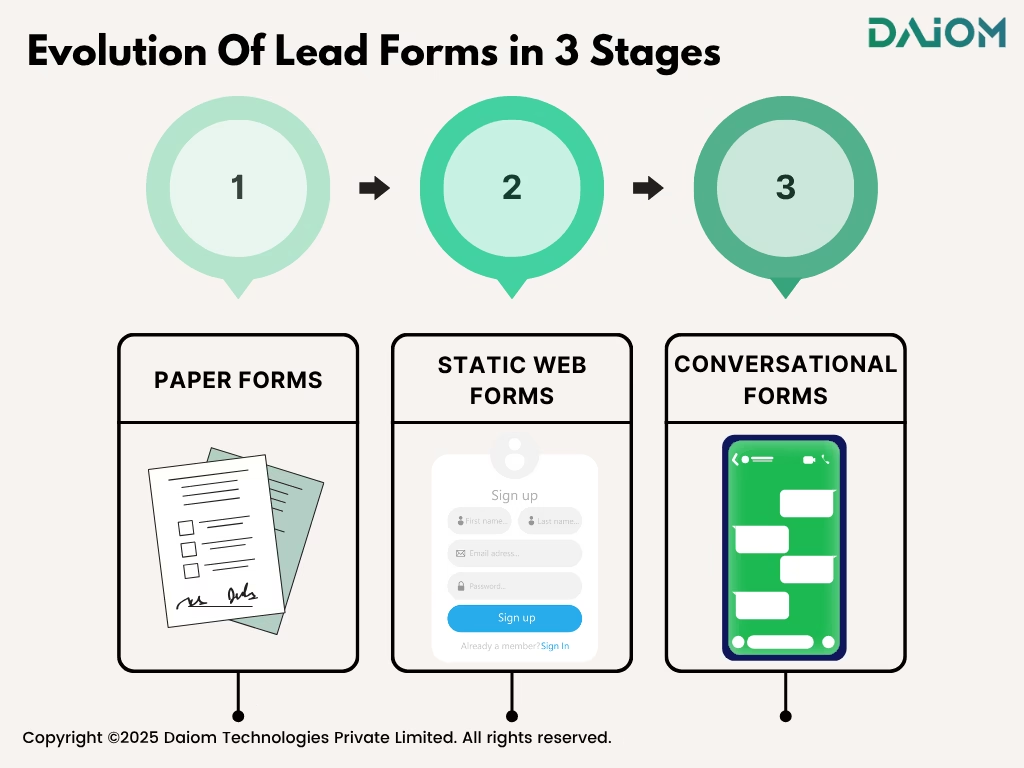
Stage 1: Discovery and long paper forms
In the early days, buying online was rare and difficult. People mostly used the internet for discovery — they browsed and researched but didn’t buy. Businesses relied on long paper forms, brochures, and sign-up sheets to collect customer details.
Stage 2: Static web forms on websites
As the internet grew, businesses moved to online forms. These were long, static forms on websites, asking for name, email, phone, preferences — all at once. But they had a major drawback: people didn’t have the time or patience, especially on mobile. Completion rates were low, sometimes just 2%, driving up the cost per lead.
Stage 3: Conversational and embedded forms
With the rise of social media and messaging apps, lead forms became smarter. We saw pre-filled lead forms inside Facebook, Instagram, and LinkedIn, making it smoother for users. Now, we’ve moved to conversational forms on platforms like WhatsApp, Messenger, and Instagram DMs.
They collect details step by step — first a phone number, then follow-up questions — often with quick-tap options. This feels natural and light for customers, improves completion rates (3–4x higher), and lowers the cost per lead while delivering better-quality leads.
2.1 How Can WhatsApp Boost Your Lead Conversions?
Many brands that have adopted Click-to-WhatsApp or used WhatsApp as a lead capture channel have seen a 2–3X increase in both lead volume and lead conversion.
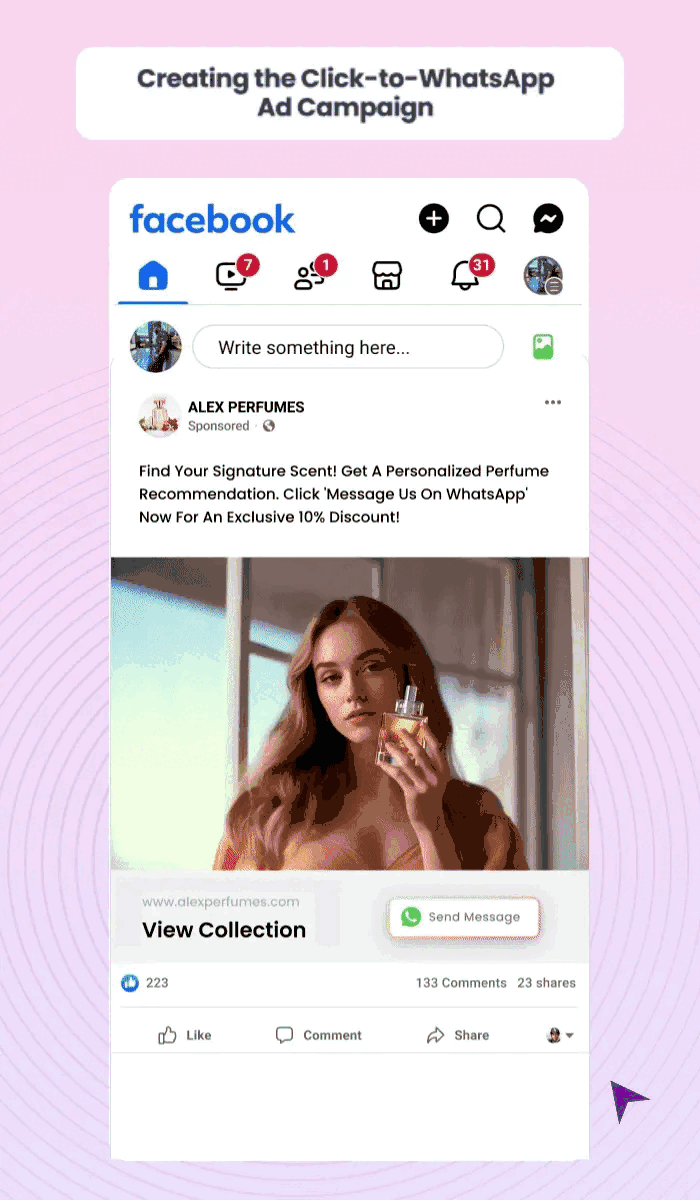
The first challenge is simply capturing the lead—and WhatsApp is proving to be a highly effective tool for doing just that. Whether it’s through conversational lead forms or integrated chat flows, brands are now meeting customers where they are and seeing tangible results.
Several success stories back this up:
HDFC Bank used WhatsApp to generate credit card leads, making it easier for users to apply directly via chat. The result: improved lead qualification and a smoother customer experience.
Tata Mutual Fund launched campaigns via WhatsApp to educate and engage potential investors, increasing both inquiries and conversions.
Blinkit integrated Click-to-WhatsApp ads to streamline customer queries, resulting in faster conversions for high-intent buyers.
MakeMyTrip leverages WhatsApp for itinerary updates and upselling—capturing additional customer interest right within the chat.
upGrad uses WhatsApp to follow up on course interest, allowing counselors to engage more personally and close leads faster.
More importantly, this approach also helps brands build their first-party database faster, which is critical in a privacy-first, cookie-less world.
Read more – Importance of 1st Party Data and Organic Ways to Build it
By modernizing lead capture through WhatsApp, businesses are not just improving efficiency—they’re laying the foundation for long-term, data-driven growth.
2.2 What’s the industry trend?
Today’s customers have shorter attention spans — they don’t want to spend time filling out long forms. The trend across industries is clear: keep forms as short as possible and prefill wherever you can.
By asking for just the most essential details upfront (like name or phone number) and filling in the rest later through follow-ups or automation, businesses can boost form completion rates and improve lead quality.
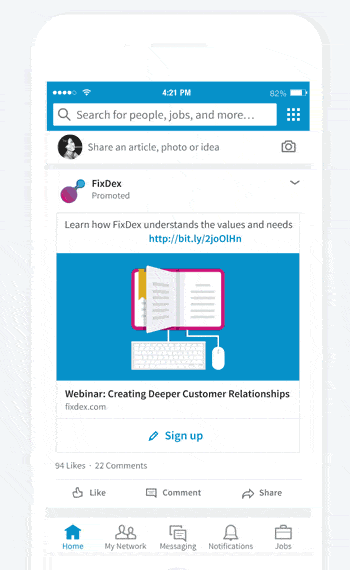
3. The Full Lead Generation Funnel
A strong lead generation journey starts with marketing campaigns. Brands run ads on platforms like Facebook, Instagram, Google, or even use offline tools like QR codes on posters, packaging, or brochures.
The main goal is simple: get people to click and land on a lead form.
The lead form collects basic customer details — name, email, phone number, or product interest — building a first-party database that sales or service teams can later use to call, message, or email leads.
This journey ends with the final conversion or sale, like booking a demo, setting up a site visit, or completing a purchase.
The simple funnel flow:
Campaign → Lead Form → Call/Message → Conversion/Sale
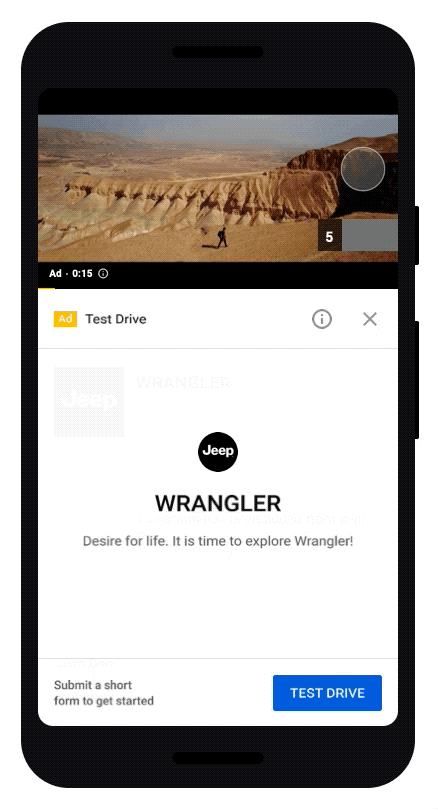
4. Common Issues with Lead Forms Today
Even though the process looks simple, many brands struggle to get the results they want. Some of the biggest roadblocks include:
- Long and complicated forms: Brands often ask for too much information upfront. Long forms overwhelm people, especially on mobile, leading to more drop-offs.
- Short attention spans: People may click the ad but leave halfway through if the form feels slow or clunky. Today’s users expect speed and simplicity.
- Friction from data validation: Asking people to verify details like phone numbers through OTPs may improve data quality, but it also makes the process feel tedious and increases the chances of losing leads.
4.1 Additional Challenge: Rising CPL and Form Fill Drop-offs
Another big challenge brands face today is the rising cost per lead (CPL). Marketers are spending more money to capture leads through campaigns across social media, QR codes, and other channels — but the form fill rates are dropping.
Why?
Because people expect instant, effortless experiences. Earlier, customers were willing to type in URLs or manually fill forms, but today they want to click once or scan a QR code and be done. If the process feels long or clunky, they’ll drop off — and the money spent to get that lead is wasted.
This makes it even more critical to simplify capture flows and reduce friction at every step. The more effortless it is to submit a lead form, the better the chances of improving completion rates and keeping Cost per lead (CPL) under control.
5. Who’s Doing It Well and Which Industries Benefit the Most?
Many companies have successfully implemented lead funnels to capture potential customers and guide them through their buying journey. Here’s how different industries use these funnels:
- Real estate companies handle property inquiries and schedule site visits, as customers need detailed information and personal assistance before deciding on a property.
- Edtech companies use lead funnels to book demo classes or schedule counseling sessions for prospective students who want to explore courses before committing.
- Sleep solution companies help customers find the right mattress, providing guidance through the lead funnel, as buyers often need advice on which product suits them best.
- Omnichannel brands like Lenskart use lead funnels for virtual try-ons and eye checkup appointments, guiding customers through the process to make informed decisions.
- QR code campaigns are also commonly used by brands to capture leads offline, offering a quick and easy way for customers to engage with businesses.
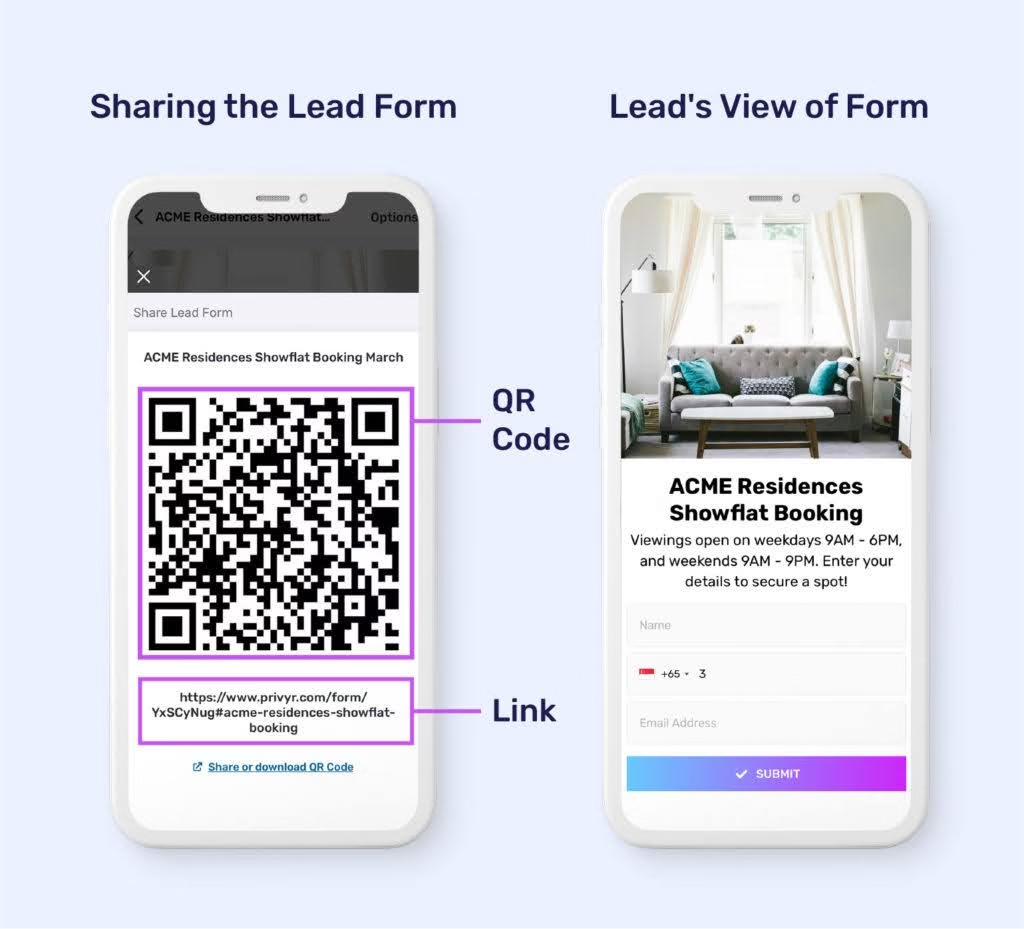
These strategies work best in industries where the buying journey is more complex and customers require additional information, guidance, or support before making a decision.
In contrast, industries like groceries or books, where the buying decision is simpler, benefit more from a quick and frictionless checkout process rather than detailed lead capture.
6. How Does Automation and AI Boost WhatsApp Lead Generation?
Using AI chatbots with WhatsApp makes lead capture much stronger:
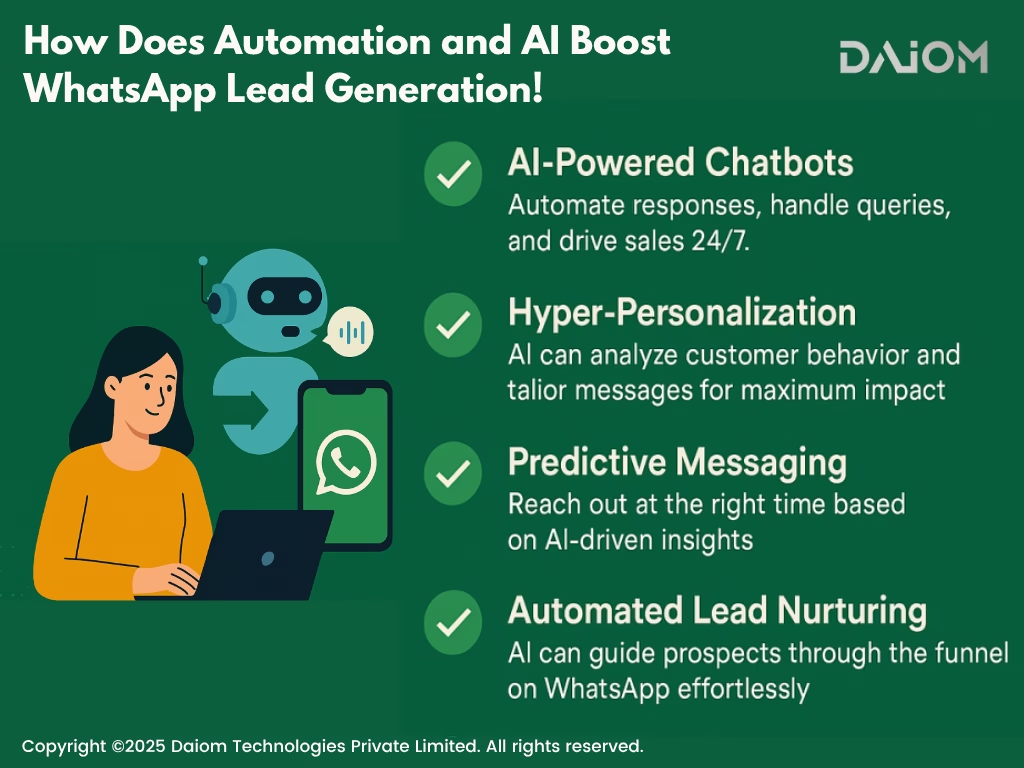
- Always On: Chatbots talk to leads 24/7 so you never miss a chance.
- Smart Filtering: AI asks the right questions to sort and score leads before sending the best ones to your sales team.
- Personal Follow-ups: Bots can send useful content, answer common questions, and guide users step by step.
- Save Money: Automating simple tasks cuts costs and lets human agents focus on tricky problems.
- Improve Over Time: Track chat performance (like response or conversion rates) and keep making it better.
7. What Are the Best Practices for WhatsApp Lead Generation?
To get the most out of WhatsApp for lead generation, businesses should follow key practices that ensure trust, personalization, and automation.
- Optimize Your Profile: Keep your WhatsApp Business profile professional and up-to-date.
- Automate Initial Responses: Use auto-replies or chatbots for instant engagement.
- Show Your Brand Personality: Be friendly and relatable in your tone and style.
- Use Click-to-WhatsApp Ads: Run ads to let users message you directly on WhatsApp.
- Share Engaging Content: Post videos, images, or tips to keep users engaged.
“In the age of instant gratification, brands that deliver real-time, personalized conversations will win the hearts — and wallets — of their customers.”
8. The Modern Conversion Journey: It’s a Loop, Not a Line
Today’s customers don’t follow a simple, straight path to purchase. Instead, their journey looks more like a loop, moving back and forth between touchpoints before they convert.
A customer might start by chatting with a brand online, then switch to a phone call for detailed questions, and return to chat for final confirmations before making a purchase. This back-and-forth — chat → call → chat → conversion — is what we call the hybrid conversational funnel.
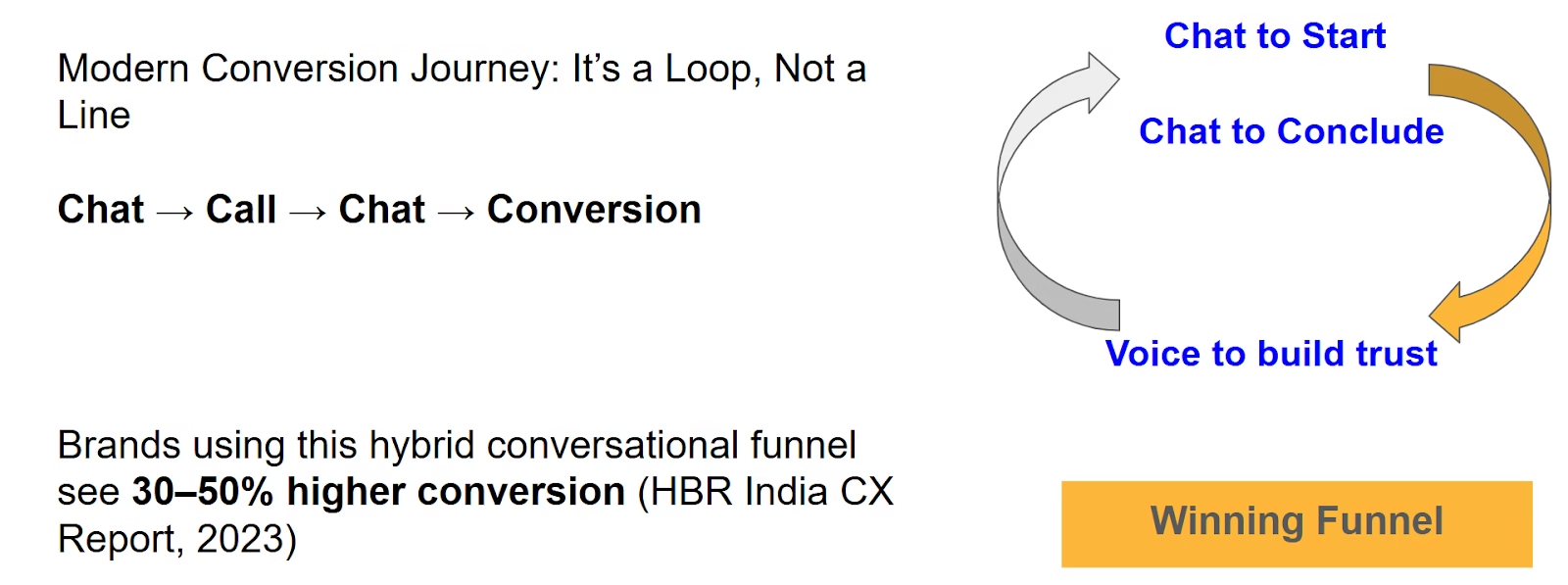
Why does this matter?
Because brands that embrace this flexible, multi-step funnel are seeing 30–50% higher conversion rates, according to the HBR India CX Report (2023). Rather than pushing customers through a rigid linear process, they create a more personalized, responsive experience — adapting to the customer’s needs at each stage.
In short, success today isn’t just about having the right tools; it’s about knowing how to combine them for a seamless, looping customer journey.
9. Conclusion
Static lead forms are rapidly becoming obsolete in an era where users demand immediacy, personalization, and convenience. Conversational messaging platforms like WhatsApp offer a superior alternative, enabling brands to capture, qualify, and convert high-intent leads through real-time, interactive dialogues.
By strategically integrating WhatsApp at key traffic entry points-websites, social ads, emails, and offline touchpoints-businesses can transform every interaction into an opportunity for engagement and conversion. With the added power of automation, AI, and CRM integration, WhatsApp is not just a messaging app-it’s a conversion engine for the modern marketer.
Looking to lower your CPL and improve lead quality? Reach out to us today!
Subscribe to our Newsletter.


